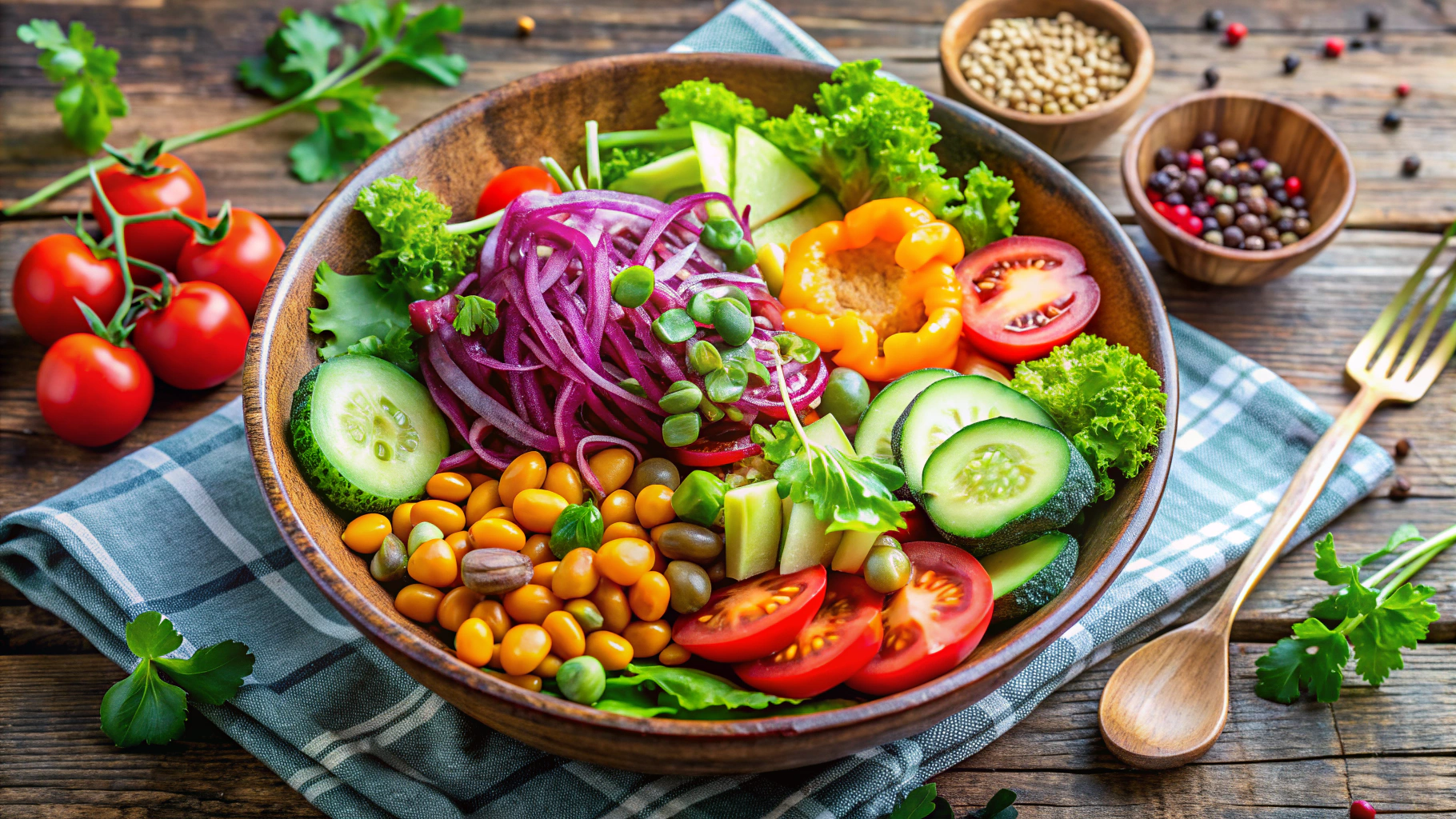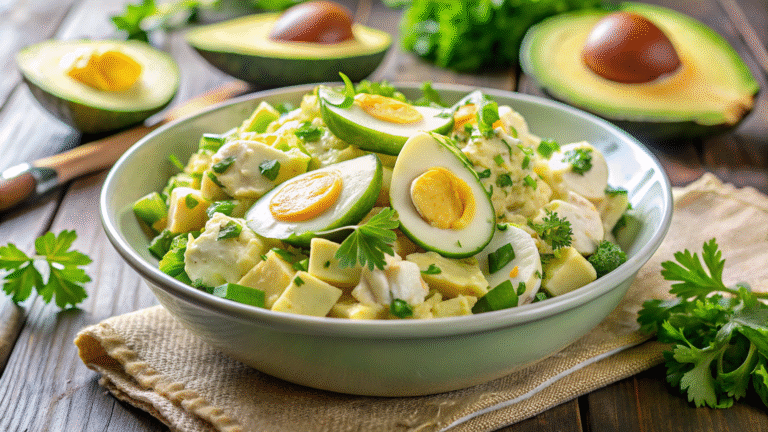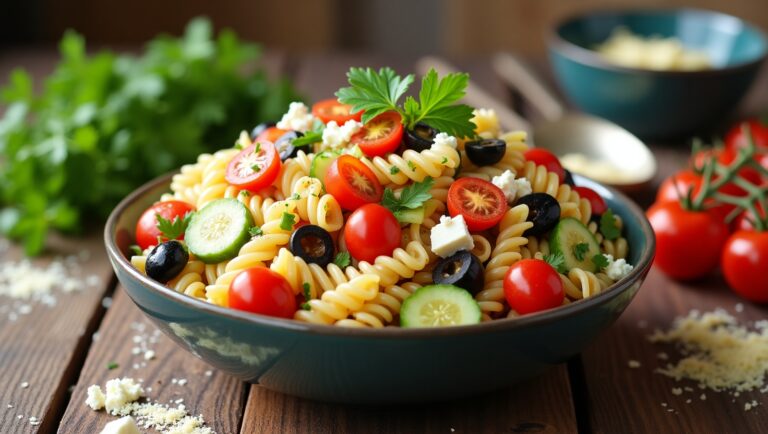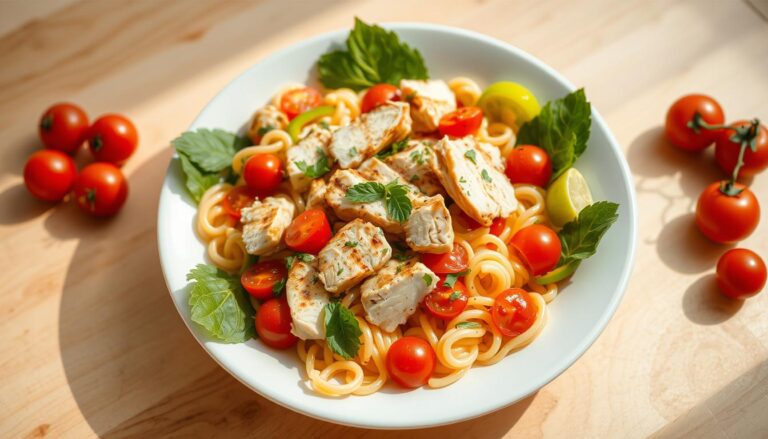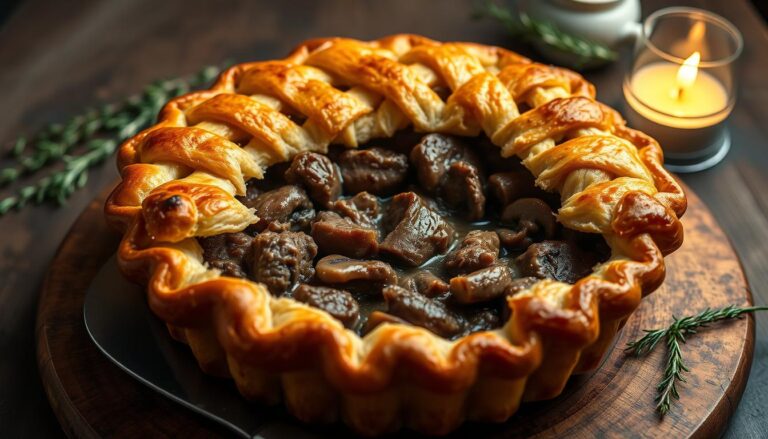Veggie Salad Bowl: A Nutritious and Delicious Lunch

Imagine turning your lunch into a colorful, healthy feast. The veggie salad bowl is more than just food. It’s a movement for those who love healthy, tasty meals.
Your lunch can say a lot about your health choices. A veggie salad bowl is full of fresh ingredients, exciting tastes, and important nutrients. It can give you energy and help you reach your health goals.
Busy people and fitness fans all over are loving these vibrant bowls. They’re great for eating more veggies, trying plant-based foods, or just enjoying a fulfilling meal. A veggie salad bowl is the perfect choice.
Key Takeaways
- Veggie salad bowls offer a nutritious and delicious lunch option
- Easily customizable to suit individual dietary preferences
- Packed with fresh vegetables and essential nutrients
- Quick to prepare and perfect for meal planning
- Supports overall health and wellness goals
Understanding the Basics of a Perfect Veggie Salad Bowl
Making a veggie salad bowl is like creating a work of art. It’s about mixing fresh ingredients, balanced nutrition, and tasty flavors. To start, you need to know the basic parts and how they come together for a healthy meal.
Essential Components for Balance
Building a veggie salad bowl needs careful thought. You aim to mix elements that please your taste and meet your nutritional needs. Think of your bowl as a canvas where fresh ingredients create a colorful picture of health.
- Base of leafy greens
- Colorful vegetable mix
- Protein sources
- Healthy fats
- Crunchy toppings
Building Blocks of Nutrition
The key to a great veggie salad bowl is its nutrient-rich ingredients. Each part adds something special to your meal. Dark leafy greens give you important vitamins, while colorful veggies offer antioxidants and minerals for wellness.
Texture and Flavor Combinations
The secret to a perfect veggie salad bowl is its mix of textures and flavors. Mix crisp veggies with creamy dressings, add crunchy nuts or seeds, and try different herbs and spices. This will make your bowl stand out.
“A great salad is a symphony of flavors and textures that dance together on your plate.” – Culinary Expert
Health Benefits of Plant-Based Bowl Meals
Switching to a plant-based diet can change how you eat. Veggie salad bowls are packed with nutrients that boost your health. These colorful meals are more than a trend; they’re a smart way to feed your body.
Your plant-based bowl can offer big health benefits:
- Boosts dietary fiber intake for better digestion
- Provides essential nutrients with few calories
- Helps manage weight
- Reduces risk of chronic diseases
These meals are full of nutrients. Each bite gives you concentrated nutrition for your body’s best function. The mix of fresh veggies, whole grains, and plant proteins makes a meal that energizes you.
Studies show that eating plant-based meals regularly can:
- Lower inflammation markers
- Improve heart health
- Boost metabolic function
- Strengthen the immune system
Choosing plant-based meals through veggie bowls is a smart health choice. The variety of ingredients gives you a wide range of vitamins, minerals, and antioxidants. These support cell growth and keep you full of energy.
Essential Ingredients for Your Veggie Salad Bowl
Making a tasty vegetarian dish begins with picking the right ingredients. Your veggie salad bowl is more than food; it’s a mix of nutrition and taste. Learning to mix different parts will make your dish stand out.
To make your veggie salad bowl amazing, focus on three key areas. These will take your dish to the next level.
Fresh Greens Selection
Your salad’s base is crucial. Choose these top greens for a great start:
- Baby spinach for iron-rich nutrition
- Crisp romaine for crunch
- Nutrient-dense kale
- Peppery arugula for flavor complexity
Colorful Vegetable Options
Adding vibrant veggies makes your bowl look good and healthy. Aim for a variety of colors for the best health benefits:
| Color | Vegetable | Nutritional Benefit |
|---|---|---|
| Red | Bell Peppers | Vitamin C boost |
| Orange | Carrots | Beta-carotene |
| Purple | Red Cabbage | Antioxidants |
| Green | Cucumber | Hydration |
Protein-Rich Add-ins
Vegetarian dishes need good protein sources to keep you full. Here are some protein-rich options:
- Plant-Based Proteins
- Chickpeas
- Tofu cubes
- Quinoa
- Nuts and Seeds
- Pumpkin seeds
- Almonds
- Sunflower seeds
By choosing your ingredients wisely, you’ll make a veggie salad bowl that’s both healthy and filling.
Preparing Your Fresh Ingredients
Making a tasty veggie salad bowl starts with fresh ingredients. How you prepare them can turn a quick meal into a long kitchen task. The goal is to get great flavor without spending too much time.
First, collect all your ingredients and tools. You’ll need a sharp knife, cutting board, and clean containers. Prepping veggies early makes your meal easy and quick.
- Rinse all vegetables thoroughly under cool running water
- Pat dry with clean kitchen towels to prevent sogginess
- Use a sharp knife for precise, consistent cuts
- Store prepped ingredients in airtight containers
For the best freshness, follow these tips. You can prep root veggies like carrots and beets up to three days early. Leafy greens stay fresh wrapped in damp paper towels in sealed containers. Herbs should be stored in water, like a small bouquet.
Pro tip: Invest in quality storage containers to keep your fresh ingredients at their peak!
Preparing your veggie salad bowl doesn’t have to be hard. With these easy steps, you’ll make a healthy meal that’s also beautiful. The more you do it, the faster and better you’ll get.
Creating the Perfect Dressing from Scratch
Making your own dressings is a big plus for a plant-based diet. A simple recipe can turn a basic salad into a feast. Your homemade dressings add flavor and let you control what you eat.
Learning to make dressings is all about trying different styles. Let’s explore three exciting types that will make your salads better.
Oil-Based Dressings: Simple and Vibrant
Oil-based dressings are key in many plant-based recipes. They are easy to make and pack a punch with flavor.
- Extra virgin olive oil base
- Fresh lemon juice
- Dijon mustard
- Minced garlic
- Sea salt and black pepper
Creamy Vegan Options: Luxurious and Nutritious
Vegan creamy dressings are rich and healthy. Ingredients like cashews, tahini, and avocados make them special.
| Base Ingredient | Flavor Profile | Preparation Time |
|---|---|---|
| Cashew Cream | Smooth, Neutral | 10 minutes |
| Tahini | Nutty, Robust | 5 minutes |
| Avocado | Creamy, Rich | 7 minutes |
Herb-Infused Varieties: Aromatic Delights
Herb-infused dressings add a special touch to your meals. Fresh herbs make simple ingredients into something amazing.
- Basil and lemon vinaigrette
- Cilantro lime dressing
- Mint and cucumber blend
Try these dressing ideas to make salads that are not only tasty but also good for you. You’ll love the flavors and the health benefits.
Step-by-Step Assembly Guide

Making a veggie salad bowl is like creating a work of art. It turns simple ingredients into a tasty and healthy meal. This guide helps you make a lunch that’s both fulfilling and nutritious.
Choose a wide, shallow bowl to display your ingredients. The secret to a great salad bowl is layering. It enhances flavor and texture.
- Start with a base of fresh greens like baby spinach or mixed salad greens
- Add roasted or raw vegetables for color and nutrients
- Include protein sources such as tofu, chickpeas, or quinoa
- Sprinkle nuts or seeds for crunch
- Finish with a homemade dressing
Your salad bowl should have a mix of textures and tastes. Try combining raw and cooked ingredients for unique flavors.
| Layer | Recommended Ingredients | Portion Size |
|---|---|---|
| Base | Arugula, Kale, Spinach | 2 cups |
| Vegetables | Roasted Sweet Potato, Bell Peppers | 1 cup |
| Protein | Chickpeas, Grilled Tofu | 1/2 cup |
| Crunch | Sunflower Seeds, Almonds | 2 tbsp |
The best thing about a veggie salad bowl is its flexibility. Don’t be afraid to try new ingredients while keeping it balanced and healthy.
Seasonal Variations for Your Bowl
Making veggie salad bowls that match the season makes healthy eating fun. Fresh ingredients are key to creating tasty and healthy meals that show off each season’s best.
Your veggie salad bowl is a blank canvas for seasonal creativity. It lets you try new flavors and get more nutrients all year round.
Spring and Summer Options
In warmer months, go for light and fresh mixes that highlight the season’s best. These vibrant bowl ideas make healthy eating easy:
- Strawberry spinach salad with goat cheese
- Cucumber and mint quinoa bowl
- Grilled zucchini and corn salad
Fall and Winter Combinations
Cooler seasons need heartier, warming ingredients for comfort and nutrition. Your veggie salad bowls can change to fit the season’s mood:
- Roasted butternut squash with kale
- Warm lentil and roasted root vegetable bowl
- Spiced sweet potato and chickpea mix
| Season | Key Ingredients | Flavor Profile |
|---|---|---|
| Spring | Asparagus, peas, radishes | Light, crisp, fresh |
| Summer | Tomatoes, cucumber, corn | Bright, refreshing, juicy |
| Fall | Squash, Brussels sprouts, apples | Earthy, rich, complex |
| Winter | Kale, sweet potatoes, beets | Hearty, warming, robust |
Using seasonal ingredients keeps your veggie salad bowls fresh, healthy, and in tune with nature’s cycles.
Make-Ahead Tips and Storage Solutions
Learning to prep your veggie salad bowl can change your eating habits. It saves time and keeps you healthy, even when you’re busy. Preparing ingredients ahead of time makes meal planning easier and cuts down on cooking stress.
Smart meal prep means preparing and storing ingredients wisely. Here are some tips to keep your salad bowls fresh and tasty:
- Wash and chop vegetables in advance
- Store wet and dry ingredients separately
- Use airtight containers for maximum freshness
- Prep proteins and grains ahead of time
Keeping ingredients fresh is key. Keep wet ingredients like dressings away from crisp veggies to avoid sogginess. Glass containers with compartments are great for keeping things fresh. Most ingredients stay good for 3-5 days in the fridge.
Your meal prep plan should include:
- Batch cooking grains and proteins
- Chopping vegetables in advance
- Creating versatile base ingredients
- Investing in quality storage containers
Using these meal prep tips, you can make tasty, healthy veggie salad bowls with little effort. Your future self will appreciate the easy, healthy meals you’ve prepared!
Customizing Your Bowl for Dietary Needs
Creating a versatile veggie salad bowl means adapting to different dietary requirements while maintaining delicious flavor profiles. Your vegetarian food choices can easily accommodate various nutritional needs with simple modifications.

Understanding dietary restrictions allows you to transform your salad bowl into a personalized meal that meets specific nutritional goals. Whether you’re managing gluten sensitivities or seeking low-carb alternatives, flexibility is key.
Gluten-Free Modifications
Transforming your bowl into a gluten-free option requires strategic ingredient swaps. Consider these alternatives:
- Replace wheat-based grains with quinoa or cauliflower rice
- Use tamari instead of traditional soy sauce
- Select certified gluten-free dressings and toppings
Low-Carb Alternatives
Reducing carbohydrate intake becomes simple with smart ingredient choices. Focus on increasing vegetable content and incorporating healthy fats.
| Low-Carb Ingredient | Nutritional Benefit |
|---|---|
| Cauliflower rice | Low calorie, high fiber |
| Zucchini noodles | Minimal carbs, nutrient-dense |
| Avocado | Healthy fats, protein |
Your veggie salad bowl can be a nutritional powerhouse that adapts to your unique dietary needs without compromising taste or satisfaction.
Portion Control and Nutritional Balance
Making a nutrient-rich veggie salad bowl is more than just mixing ingredients. It’s about knowing how much to eat and balancing nutrients. You want to make a meal that’s full of nutrition but not too heavy.
To balance your bowl, pick ingredients wisely and measure them carefully. Here’s a simple guide to making a balanced veggie salad:
- Greens: Fill half your bowl with leafy vegetables
- Proteins: Allocate about 1/4 of the bowl to protein sources
- Complex carbohydrates: Use the remaining 1/4 for grains or starchy vegetables
Choosing the right ingredients is key to a healthy diet. Here are some protein-rich options that help with portion control:
- Chickpeas
- Quinoa
- Tofu
- Edamame
“Eating mindfully is about quality, not just quantity” – Nutrition Expert
Remember, portion sizes depend on your personal needs. Your activity level, metabolism, and health goals affect how much you should eat. Paying attention to your hunger and fullness is important for healthy eating.
By focusing on nutrient density and portion sizes, your veggie salad bowl becomes a powerful tool for your health. It turns a simple meal into a key part of your wellness.
Popular Veggie Bowl Combinations
Exploring global flavors can make your veggie salad bowl exciting. A plant-based diet is more fun with different cuisines. These bowls offer nutritious and tasty meals that keep your taste buds happy.
Mediterranean Style Bowl
Mediterranean cuisine is great for veggie bowls. It uses fresh ingredients and vibrant flavors. This style focuses on whole foods and plant-based items for a healthy diet.
- Quinoa base
- Roasted red peppers
- Cucumber
- Kalamata olives
- Crumbled chickpeas
Asian-Inspired Bowls
Asian cuisine adds unique textures and umami flavors. These bowls mix crisp veggies with interesting proteins.
| Ingredient | Quantity |
|---|---|
| Edamame | 1/2 cup |
| Pickled Radish | 1/4 cup |
| Sesame Tofu | 3 oz |
| Brown Rice | 1/2 cup |
Mexican Fiesta Bowl
Add Mexican flair to your veggie bowl for flavor and nutrition. This mix makes a satisfying and colorful meal.
- Black beans
- Roasted corn
- Diced tomatoes
- Avocado slices
- Cilantro-lime dressing
Each global veggie bowl style offers a unique way to enjoy a plant-based diet. Try different ingredients and find your favorite!
Conclusion
Your journey into veggie salad bowls is more than just a meal choice. It’s a commitment to healthy eating that changes how you view nutrition. These versatile bowls let you try new combinations and nourish your body with important nutrients.
Every veggie salad bowl you make is a chance to express yourself. You can go for a Mediterranean mix or an Asian-fusion bowl. These bowls fit your taste and dietary needs, making meals exciting and tasty.
Adding veggie salad bowls to your daily meals can change your nutrition approach. By using fresh, whole ingredients and balanced mixes, you support your health goals. Start with small steps, be bold, and see how these meals boost your energy and taste buds.
Your journey to vibrant, tasty, and healthy eating starts with a veggie salad bowl. Explore the possibilities, trust your cooking skills, and enjoy the amazing flavors and health perks in every bite.

